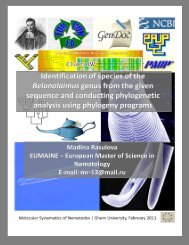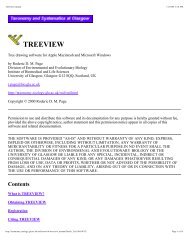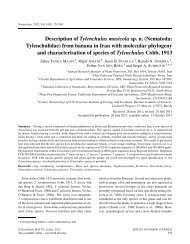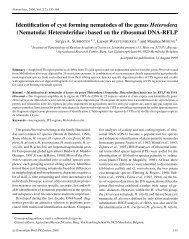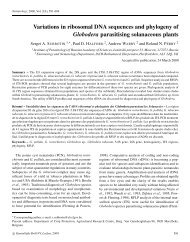Morphological and molecular characterisation of Californian species ...
Morphological and molecular characterisation of Californian species ...
Morphological and molecular characterisation of Californian species ...
Create successful ePaper yourself
Turn your PDF publications into a flip-book with our unique Google optimized e-Paper software.
Studies on Metaporcelaimus<br />
clusion in Metaporcelaimus rather than Aporcelaimellus.<br />
Jana <strong>and</strong> Baqri (1981) described three females <strong>and</strong> one<br />
male belonging to this <strong>species</strong> but having a larger general<br />
size (body length 1.51-1.90 mm in females, 1.88 in<br />
male) which exceeds the range <strong>of</strong> the type population<br />
(body length 0.96-1.42 in females, no male) <strong>and</strong> raises<br />
some doubts as to the identity <strong>of</strong> this material.<br />
Metaporcelaimus conoidus comb. n.: A recent reexamination<br />
<strong>of</strong> type material <strong>of</strong> this <strong>species</strong> (Álvarez-<br />
Ortega & Peña-Santiago, 2010a) revealed that some <strong>of</strong> its<br />
distinctive features (inner cuticle layer apparently bearing<br />
a terminal discontinuity; slender body, a = 36-42; <strong>and</strong><br />
conical tail with rounded terminus, c ′ = 1.3) better fit the<br />
pattern <strong>of</strong> Metaporcelaimus than that <strong>of</strong> Aporcelaimellus.<br />
Metaporcelaimus cylindricus comb. n.: The true identity<br />
<strong>of</strong> this taxon deserves further study, but the morphology<br />
<strong>of</strong> its tail (conical, lacking a continuous <strong>and</strong> refractive<br />
inner layer) supports its provisional transference to Metaporcelaimus.<br />
Metaporcelaimus donghwaens comb. n.: The general<br />
morphology <strong>of</strong> this <strong>species</strong>, especially that <strong>of</strong> the caudal<br />
region, perfectly fits the new concept (conical tail, inner<br />
cuticle layer bearing a distinct discontinuity, inner core<br />
with a terminal digitation) <strong>of</strong> Metaporcelaimus <strong>and</strong> justifies<br />
its transference to this genus.<br />
Metaporcelaimus efficiens: The true identity <strong>of</strong> this<br />
<strong>species</strong> remains obscure. Thorne & Swanger’s (1936)<br />
original description is very poor in detail, but Andrássy<br />
(2001) transferred it from Aporcelaimellus to Metaporcelaimus,<br />
an action which is provisionally followed here.<br />
Thorne & Swanger (1936) mentioned that Dorylaimus efficiens<br />
was very similar to D. simplex, also originally described<br />
by them, a <strong>species</strong> recently transferred from Metaporcelaimus<br />
to Aporcella by Álvarez-Ortega et al. (2013).<br />
On the other h<strong>and</strong>, M. efficiens is very similar, if not identical,<br />
to M. raniensis (see below), from which it can be<br />
distinguished by minor morphometric differences derived<br />
from the study <strong>of</strong> only one female in each case.<br />
Metaporcelaimus indicus comb. n.: Andrássy (2001)<br />
regarded this <strong>species</strong> as a junior synonym <strong>of</strong> M. mombucae,<br />
but there are several morphometric differences between<br />
them, namely larger (L = 2.40-2.45 vs 1.83-2.34)<br />
<strong>and</strong> more slender (a = 49-52 vs 28-42) body, more posterior<br />
vulva (V = 57-58 vs 50-56), comparatively shorter<br />
tail (c = 41-43 vs 30-36) <strong>and</strong> male unknown vs known.<br />
On the other h<strong>and</strong>, assuming that the pars refringens vaginae<br />
is absent, the general morphology <strong>of</strong> this <strong>species</strong> also<br />
fits that <strong>of</strong> some members <strong>of</strong> Discolaiminae, although the<br />
general size is larger. Hence, further studies are needed<br />
to clarify its identity, although its conical tail <strong>and</strong> resemblance<br />
to M. mombucae suggests it should be provisionally<br />
classified under Metaporcelaimus rather than under<br />
Aporcelaimellus.<br />
Metaporcelaimus insignis comb. n.: A recent re-examination<br />
<strong>of</strong> type material <strong>of</strong> this <strong>species</strong> (Álvarez-Ortega &<br />
Peña-Santiago, 2011) revealed that some <strong>of</strong> its distinctive<br />
features (slender body, a = 35-40; <strong>and</strong> conical tail with<br />
finely rounded terminus, c ′ = 1.6-1.9) better fit the pattern<br />
<strong>of</strong> Metaporcelaimus than that <strong>of</strong> Aporcelaimellus.<br />
Metaporcelaimus littoralis comb. n.: Although the original<br />
description <strong>of</strong> this <strong>species</strong> is not very detailed, the<br />
morphology <strong>of</strong> the caudal region (conical with rounded<br />
terminus, apparently with a terminal discontinuity <strong>of</strong> inner<br />
cuticle layer, <strong>and</strong> short or notched inner core) seems<br />
more similar to Metaporcelaimus than to Aporcelaimellus,<br />
the reason why it is transferred to the former genus.<br />
Metaporcelaimus parangalitzi comb. n.: Tail morphology<br />
(conical with inner core forming a terminal digitation)<br />
in this <strong>species</strong> fits well the Metaporcelaimus pattern.<br />
Metaporcelaimus parmus comb. n., M. placus comb.<br />
n. <strong>and</strong> M. thornei comb. n.: Álvarez-Ortega & Peña-<br />
Santiago (2010a) have recently re-described or described<br />
these <strong>species</strong> on the basis <strong>of</strong> type material. In all three<br />
cases the tail is conical, with the inner cuticle layer weakly<br />
refractive <strong>and</strong> discontinuous at the end, <strong>and</strong> the inner core<br />
irregular <strong>and</strong> with terminal digitation.<br />
Metaporcelaimus raniensis comb. n.: Altherr’s (1968)<br />
original description <strong>of</strong> this <strong>species</strong>, based on only one<br />
female, lacks many details <strong>and</strong> contains some inconsistencies,<br />
for instance the morphometrics <strong>of</strong> the caudal region<br />
significantly differ when data from text <strong>and</strong> those obtained<br />
from illustrations are compared. Andrássy (2002b)<br />
regarded it as a junior synonym <strong>of</strong> Aporcelaimellus taylori<br />
Yeates, 1967, but there are some relevant differences between<br />
both taxa: more slender body in M. raniensis (a =<br />
44 vs 29), pars refringens vaginae present vs absent, <strong>and</strong><br />
more posterior vulva (V = 57 vs 50). It is herein regarded<br />
as a valid <strong>species</strong> <strong>and</strong>, due to its conical tail with inner<br />
core nearly reaching the terminus, provisionally classified<br />
under Metaporcelaimus.<br />
Metaporcelaimus shamimi comb. n.: Tail morphology<br />
(conical with finely rounded tip with a terminal discontinuity<br />
<strong>of</strong> inner cuticle layer) in this <strong>species</strong> fits well the<br />
Metaporcelaimus pattern.<br />
Metaporcelaimus silvanus comb. n.: The conical tail<br />
with finely rounded tip <strong>of</strong> this <strong>species</strong> supports its inclusion<br />
in Metaporcelaimus.<br />
Vol. 00(0), 2012 21



